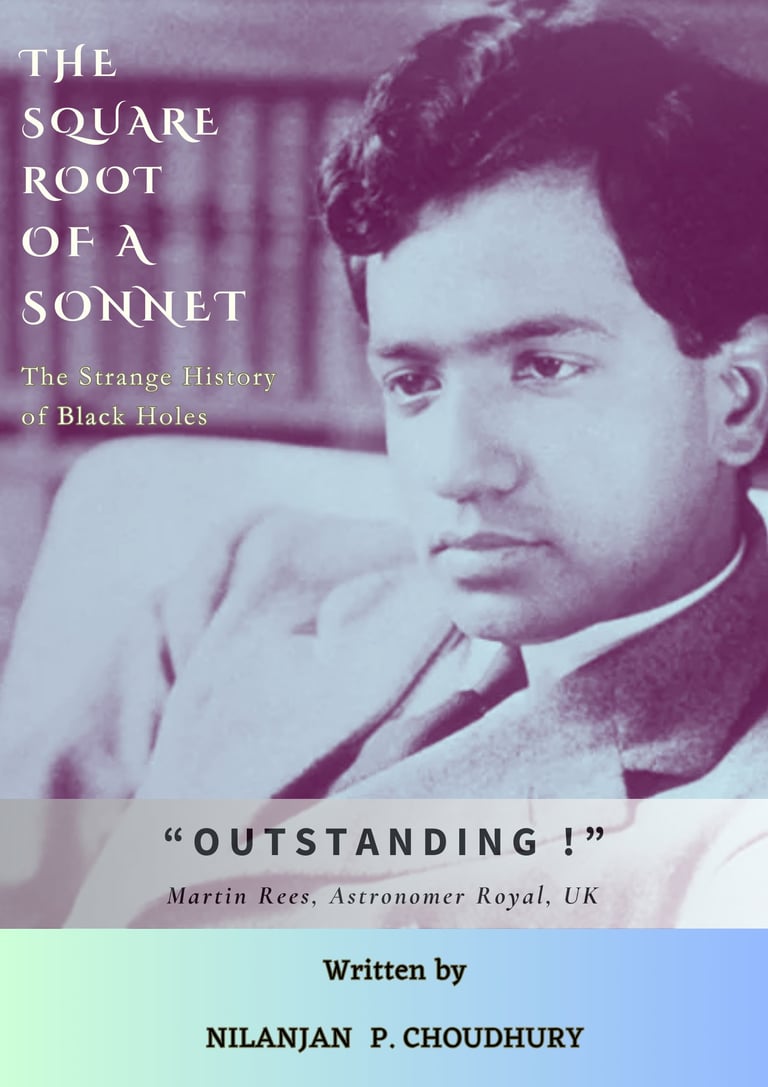THE SQUARE ROOT
OF A SONNET
The Strange History of Black Holes
In the summer of 1930, a nineteen-year-old Indian boy set sail for England, to study physics at Cambridge University. During the sea voyage from Bombay to Dover, he formulated the fundamental equations that govern the ultimate fate of the stars in our Universe. To his surprise, his calculations showed that contrary to accepted belief, certain stars were destined to meet a violent end, inexorably collapsing into extremely dense and tiny objects called neutron stars (which may further implode to become those exotic creatures we now know as black holes). The boy’s name was Subrahmanyan Chandrasekhar, the brilliant Indian-American astrophysicist, whose discovery of the gravitational collapse of stars had opened the gateway to the strange new science of black holes.
But Chandra himself had to wait for fifty-three years for work to be recognized in the form of a Nobel Prize – for his path breaking research had been suppressed almost as soon as it had been made, in 1930. And the person responsible for it was Chandra’s own guru and hero – Sir Arthur Eddington, Professor of Astronomy at Cambridge, and the foremost astrophysicist of the age. Why did Eddington try to destroy Chandra’s work? For a man renowned for his dispassionate commitment to the cause of science, Eddington’s actions have been a long-standing mystery. Was it because of his unshakeable belief in a profoundly logical God, who would never allow the existence of an object as unnatural as a black hole? Or was it because of professional rivalry, or deep-rooted racial prejudice? Or were there other forces at work?
“The Square Root of a Sonnet” explores the intriguing and complex relationship between two giants of modern astrophysics – Chandra and Eddington. It is a story of ambition, friendship and betrayal set against the back drop of the epoch-making events of the twentieth century – the two great world wars, the Indian freedom struggle and above all, the birth of the strange new sciences of relativity and quantum mechanics.
A story of ambition, friendship and betrayal set against the back drop of the epoch-making events events of the twentieth century – the two great world wars, the Indian freedom struggle and above all, the birth of the strange new sciences of relativity and quantum mechanics.



PRAISE FOR THE PLAY
"Original...entertaining...outstanding." - Martin Rees, Astronomer Royal, UK
“It is refreshing to celebrate the actual achievements of an Indian scientist in a time when too many imaginary achievements of ancient Indian science are being propagated.” – Naseeruddin Shah.
"...presents the struggles and triumphs of one of the most significant yet under appreciated figures in astrophysics...a reminder of the enduring power of scientific inquiry and irreverence." - Nature
“Top marks for portraying such nuanced characters on stage along with distilling their complex scientific work.” – The Week
“An excellent exemplar. Presented lucidly...nothing pleases the mind more than ideas and feelings expressed in intelligent conversation.” – The Telegraph
“Theatre proved a winner yet again for being a powerful medium of portraying a story of a complicated friendship, betrayal and larger than life ideas. The script, peppered with insightful humour, was the star of the show.”– The Hindu
"Masterfully crafted ... a perfect amalgamation between science and the performing arts." - American Kahani
"We were amazed by the very strong and sensitive text of the play. I believe that this will come to be regarded as a major piece of dramatic literature from India. In spite of some difficult dialogues with non-trivial physics, the brilliant teamwork of the actors kept the audience completely captivated for two hours” – Prof. Arnab Rai Choudhuri, JC Bose Fellow & Professor (Astrophysics), Indian Institute of Science. Bangalore.
